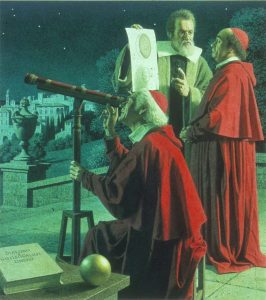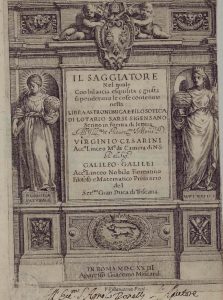
Who does not know Galileo Galilei? For many, the founder of modern science, is probably best known for his conviction in 1633 by the Court of the Inquisition in Rome (for defending Copernicus’ Heliocentric Theory) and his famous sentence at the end of the trial after he recanted “eppur si muove” (and yet it moves) –which he almost certainly never said– than for his contributions to modern science. Even his work is usually remembered for his last two books, The Dialogues and The Discourse on Two New Sciences. His Dialogo sopra i due massimi sistemi del mondo (usually known as the Dialogues on the Two World’s Greatest Systems or The Dialogues) was published in 1632 and, as its name suggests, in it Galileo discusses the geocentric theories of Aristotle and Ptolemy and the heliocentric theory of Copernicus (although proposed by Aristarchus of Samos some 1800 years earlier). This work was ultimately the one that cost him his sentence by the Inquisition in 1633 because it provided evidence in favour of the Copernican model. In the Discorsi e dimostrazioni matematiche, intorno a due nuove scienze attenenti alla meccanica & i movimenti locali (known as Discourse on two new sciences), published in 1638 while already under house arrest, he developed the bases of Classical Mechanics (the result of his research during his years in Padua). It was undoubtedly the publication that initiated modern science. Although we could talk thoroughly about these two books, in this entry I would like to comment briefly on an earlier book, a great unknown to many, published by Galileo in 1623 under the pompous name Il Saggiatore, nel quale con bilancia squisita e giusta si ponderano le cose contenute nella Libra astronomica e filosofica di Lotario Sarsi (The Assayer in which with exquisite and fair balance the things contained in Lotario Sarsi’s astronomical and philosophical Libra are weighted) commonly known as Il Saggiatore (Here you have a scan of the work with handwritten notes by Galileo himself).

Il Saggiatore has a peculiar history: it was written by Galileo in response to two books that the Jesuit Horacio Grassi published in 1619 to explain the appearance of three comets in November 1618, where, in particular, he defended the Tychonic model (proposed by the Danish astronomer Tycho Brahe) and in the second of which, entitled Libra astronomica ac philosophica (written under the pseudonym Lotario Sarsi), its author directly attacked Galileo. Galileo, who was a polemist wherever he was, began to write his response in the form of a letter (which was initially very cautious) but ended up writing Il Saggiatore challenging each and every one of Sarsi’s proposals. Galileo used the term “saggiatore” (rehearser) in the title, which was also the name given to the precision scales used by jewellers; he did this to make fun of Sarsi’s aforementioned work – which Galileo knew was Grassi’s pseudonym – as the term “Libra” used in his title was also used to name a very imprecise Roman scale (or weight). Although Galileo’s explanation of comets in The Assayer was wrong, the book played an essential role in the subsequent development of science, as it was precisely in this book that Galileo first set out the basis of the scientific method we use today: a combination of observation, mathematical deduction and experimentation. It should also be noted that The Assayer was very influential in Italy where it is considered a literary masterpiece because of its controversial and biting style.
Perhaps in another entry we can discuss with some simple examples how the scientific method works. In this one I will focus on two statements made by Galileo in Il Saggiatore whose consequences have shaped the modern world as we know it today, and which are the synthesis of the scientific method mentioned above.
In the first of these, Galileo establishes the importance of experimentation in understanding natural phenomena, making it clear that observation and experimentation must prevail over theoretical reasoning (what a mathematical colleague often –and wisely– calls “the reduction of nature to the absurd”). Galileo stated:
But I say that it seems to me something new that someone should try to put the testimony of men before what experience shows us. Presenting so many testimonies, Mr. Sarsi, is useless, since we have never denied that many have written and believed such a thing, but we have said that such a thing is false; as far as authority is concerned, it is just as important to have one’s own authority as it is to have a hundred together, to make the effect true or not. […] I cannot help but marvel again at Sarsi’s insistence on testing me by testimony, which he can see at any moment through experience.
In the second statement, which is certainly one of the mathematicians’ favourite quotes, Galileo establishes the unbreakable link between mathematics and natural phenomena by stating that
[ Natural ] philosophy is written in that great book that we have open before our eyes (I mean, the universe), but it cannot be understood if one does not first learn to understand its language, to learn the letters in which it is written. It is written in mathematical language and its symbols are triangles, circles and other geometrical figures, without which it is impossible to understand a single word; without them it is like turning vainly in a dark labyrinth.
This statement was indeed revolutionary. In it Galileo made it clear that to understand natural phenomena a qualitative (word-based) explanation was not enough, but that one had to be able to give a quantitative (numerical) explanation of things as well. Galileo clearly knew what he was talking about because he had spent long years (essentially during his stay as professor of mathematics at the University of Padua from 1592 to 1610) systematically studying the fall of bodies, among other things, establishing very precise mathematical relationships and laws. From then on, mathematics would be an unavoidable weapon to describe the world around us: a world that is cognisable thanks to experimentation and that can be described using mathematics. Mathematics, that human invention as many great scientists of our time have said, would be from that moment on the language of the Universe, the language that would allow us to unravel the mysteries of nature. It is fair to say, then, that with The Assayer the change in our conception of nature began to take place. This conception was consolidated years later by Newton with the publication of his Principia, and is none other than the quantitative explanation of it by means of rationality and, of course, mathematics. And this is only the beginning, because as they say Laplace said before his death “Ce que nous connaissons est peu de chose, ce que nous ignorons est immense” (What we know is little, what we do not know is immense).
Recommended reading: José E. Marquina, Rosalía Ridaura, José Luis Álvarez y Manuel Quintana, Il Saggiatore. Un libro poco recordado, Ciencias, núm. 41, 1996, enero-marzo, pp. 4-8.

El debate continua mas de 300 años despues…
Jacob Bronowsk (1908-1974), en “The Origins of Knowledge and Imagination” (Yale U.P. 1978) in the last chapter, Law and Individual Responsibility” , (pp.126-127):
… Well, unhappily, between 1500 and 1600 a number of such forgeries turned
up in very important Church documents. And the men of Florence and Milan were astonished to think that there had been a time in the history of the Church when it was thought that in order to convert the faithful to the Glory of God it was all right to put forged documents into the records.
Now so far, I have been speaking only of the scientific enterprise as taking its strength from the fact that everybody can believe what everybody else says. But in the end, after all, what is science discovering except what is the case? How do we build norms of conduct on that? And I want now to turn to the norms of conduct in the scientific community that arise from this.
it is basic to the concept of truth as practiced in science that it is an absolute command in every detail. There is no distinction between good means and good ends. You are only allowed to employ perfectly honest means. This is what puts you in a positition of special trust. And this is a deeply ethical principle. …